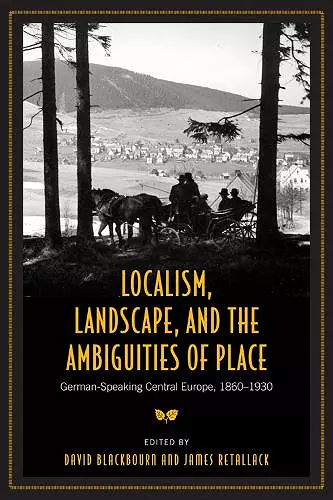Localism, Landscape, and the Ambiguities of Place
German-Speaking Central Europe, 1860-1930
David Blackbourn editor James Retallack editor
Format:Paperback
Publisher:University of Toronto Press
Published:17th Sep '14
Currently unavailable, and unfortunately no date known when it will be back

'Localism, Landscape, and the Ambiguities of Place is an outstanding edited collection that will have to be read by anyone with a serious interest in Imperial Germany ... This is truly a fabulous and path-breaking book that makes an invaluable contribution to the study of German history.' -- Jan Palmowski, University of Warwick 'A fresh and evocative study of the interplay between landscapes and localities in the shaping of modern German culture, politics, ideology, and identity.' -- Michael B. Gross, East Carolina University, Central European History
These essays do not assume the primacy of national allegiance. Instead, by using the ‘sense of place’ as a prism to look at German identity in new ways, they examine a sense of ‘Germanness’ that was neither self-evident nor unchanging.
What makes a person call a particular place 'home'? Does it follow simply from being born there? Is it the result of a language shared with neighbours or attachment to a familiar landscape? Perhaps it is a piece of music, or a painting, or even a travelogue that captures the essence of home. And what about the sense of belonging that inspires nationalist or local autonomy movements? Each of these can be a marker of identity, but all are ambiguous.
Where you were born has a different meaning if, like so many modern Germans, you have moved on and now live elsewhere. Representing the 'national interest' in parliament becomes more difficult when voters demand attention to local and regional issues or when ethnic tensions erupt. In all these situations the landscape of 'home' takes on a more elusive meaning.
Localism, Landscape, and the Ambiguities of Place is about the German nation state and the German-speaking lands beyond it, from the 1860s to the 1930s. The authors explore a wide range of subjects: music and art, elections and political festivities, local landscape and nature conservation, tourism and language struggles in the family and the school. Yet they share an interest in the ambiguities of German identity in an age of extraordinarily rapid socio-economic change. These essays do not assume the primacy of national allegiance. Instead, by using the 'sense of place' as a prism to look at German identity in new ways, they examine a sense of 'Germanness' that was neither self-evident nor unchanging.
‘The contribution this volume makes to the field of cultural studies goes well beyond its German scope. Its greatest contribution – the whole being larger than the sum of the parts – lies in its testing and stretching of theories of place and identity. In the end, Localism, Landscape, and the Ambiguities of Place exposes some of the very assumptions that have gone into the notion of hybridity itself.’
-- Peter Blickle * German Quarterly *
‘[Blackbourn and Retallack] address the important question of how these various possible forms of collective identification could be combined in the minds of individuals ... [By focusing] the lens on the subnational level to trace ambiguous feelings of belonging over time ... the volume reminds us that questions of German identities became more, not less, complicated with the foundation of the Empire.’
-- Christian Müller * The Historical Journal: vol 53:03:10 *
ISBN: 9781442628656
Dimensions: 228mm x 152mm x 17mm
Weight: 470g
288 pages